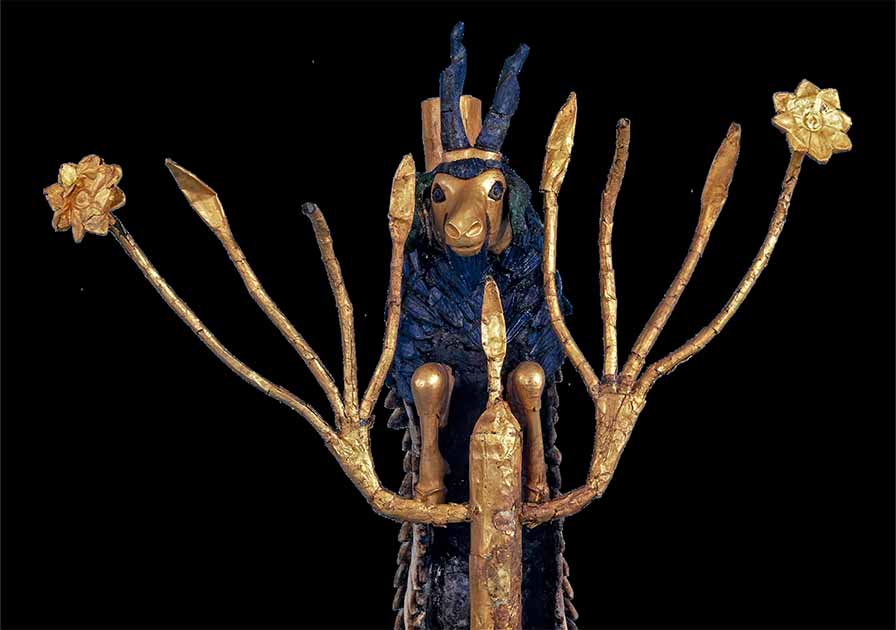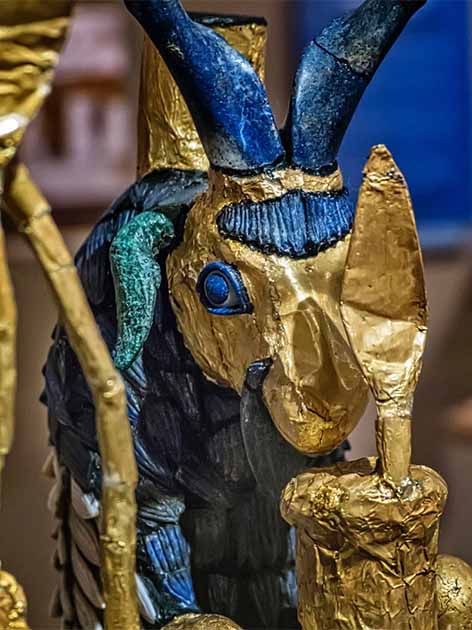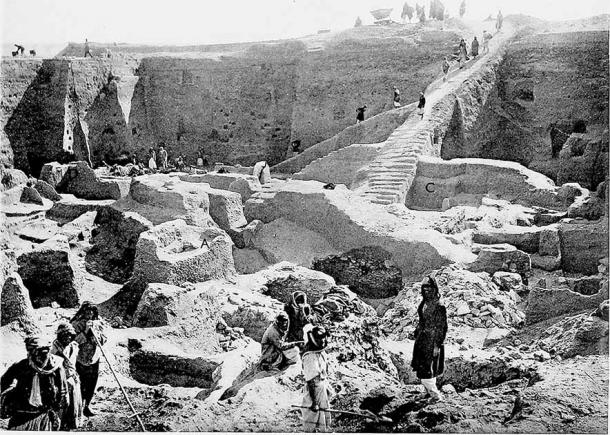Ram in a Thicket: An Ancient City of Ur’s Mesopotamian Legacy

The treasures of ancient cultures are a source of never ending inspiration. It is such a wonder to see the magnificence of the art that was created in the dawn of civilization, so long before our time. The Ram in a Thicket is an ideal example of how industrious people were at a time when tools and knowledge were still in their infancy. An exquisite treasure from the Sumerian city-state of Ur, the pair of ram sculptures were buried in a tomb that could have belonged to Mesannepada, a King of the First Dynasty of Ur, who reigned around 2600 BC.

One of the Ram in a Thicket statues on display at the British Museum. (Public domain)
The Ram in a Thicket Endured for Centuries
The “Ram in a Thicket” is not a single ancient statue but a pair of remarkable Sumerian sculptures that date back to between 2600 and 2400 BC. These statues were discovered by archaeologists in the ancient city of Ur, which is located in modern-day Iraq.
Sir Leonard Wooley discovered the Ram in a Thicket when excavating the vast Royal Cemetery of Ur, in his 1928 to 1929 season. They are considered some of the most iconic and well-preserved artifacts from the Sumerian civilization.
Sumer: Where Written Language, Arithmetic and Civilization Were Born
15 Fascinating Facts About the Sumerians
When discovered, however, the figures were nearly crushed flat by the weight of the soil, and the inner wooden core had decomposed after the long centuries of being buried. The outer materials, however, survived, and were painstakingly put back into correct shape.
The Ram in a Thicket statues depict two rams, or more precisely, goats, with each one holding a stylized tree or plant. The central feature of these sculptures is a representation of a ram caught in a thicket, which gives the artwork its name. For it seems that Leonard Wooley was reminded of the Biblical story of Abraham, who had to sacrifice his son Isaac, but was stopped at the last moment by an angel who revealed a ram caught in a thicket by its horns, which was sacrificed instead.
“Abraham looked up and there in a thicket he saw a ram caught by its horns. He went over and took the ram and sacrificed it as a burnt offering instead of his son.” (Genesis 22:13)

The famous Ram in a Thicket statue recovered from the Royal Cemetery of Ur in Iraq. (Mary Harrsch / CC BY 2.0)
The Masterful Ancient Craftsmanship Demonstrated by Ram in a Thicket
Originally, the figures were made of a roughly hewn wooden core, over which were placed different materials such as gold leaf, lapis lazuli and shell inlays. These were attached with bitumen. The details that went into making the Ram in a Thicket are incredible, and they were most certainly commissioned for a member of the Sumerian royal family. The combination of materials and the craftsmanship involved in creating these sculptures demonstrate the advanced artistic and metallurgical skills of the Sumerians.
The statues are believed to have had religious or ritual significance. They might have been used in temple ceremonies, representing offerings and gifts to the gods, particularly in connection with the Sumerian goddess Inanna, the goddess of love and war. In their original state, it is believed that the two sculptures were placed opposite to one another, and that bowls or similar vessels were placed on small stands that exist on top of the heads.
The Ram in a Thicket sculptures date back to the Early Dynastic III period of ancient Mesopotamia, around 2600 to 2400 BC. This was a time when Ur was one of the leading cities of Sumer, and the region was known for its advanced civilization, which included the invention of writing (cuneiform) and the emergence of complex city-states.
Nevertheless, it remains unknown in whose grave exactly the sculptures were discovered, though it is commonly believed that it was the resting place of King Mesannepada (Mesh-Ane-Pada), son of famed King Meskalamdug. The tomb was nicknamed “The Great Death Pit”, because it housed numerous human remains; including the servants and guards that were killed in order to follow the King into the afterlife. Amongst their remains were the two ram sculptures, alongside other valuable items.

Image of excavations at the Royal Cemetery of Ur, part of a joint expedition of the British Museum and the Museum of the University of Pennsylvania to Mesopotamia. The Ram in a Thicket statues were discovered by Sir Leonard Wooley during his 1928 to 1929 season. (Public domain)
The Enigmas of Ancient Ur
Ancient Ur, and the Sumerians as a whole, are still a source of great mystery. History does not remember all that much about them, and there is still a lot to be discovered. But as long as majestic discoveries are made, such as the Ram in a Thicket, the Sumerian story will continue to unravel. They provide a valuable window into the art and religious practices of one of the world’s oldest advanced civilizations—the people from whom everything began.
Today, the Ram in a Thicket sculptures are separated. One is housed in the British Museum in London, where it is on display as part of the museum’s extensive collection of ancient artifacts. The other one isdisplayed at the University of Pennsylvania Museum in Philadelphia, USA. Together, these sculptures provide valuable insights into the art, culture and religious practices of the Sumerians, one of the world’s earliest known civilizations.